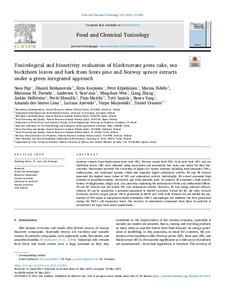Toxicological and bioactivity evaluation of blackcurrant press cake, sea buckthorn leaves and bark from Scots pine and Norway spruce extracts under a green integrated approach
Pap Nora; Reshamwala Dhanik; Korpinen Risto; Kilpeläinen Petri; Fidelis Marina; Furtado Marianna M.; Sant’Ana Anderson S.; Wen Mingchun; Zhang Liang; Hellström Jarkko; Marnilla Pertti; Mattila Pirjo; Sarjala Tytti; Yang Baoru; Lima Amanda dos Santos; Azevedo Luciana; Marjomäki Varpu; Granato Daniel
https://urn.fi/URN:NBN:fi-fe2022012710580
Tiivistelmä
Aqueous extracts from blackcurrant press cake (BC), Norway spruce bark (NS), Scots pine bark (SP), and sea buckthorn leaves (SB) were obtained using maceration and pressurized hot water and tested for their bioactivities. Maceration provided the extraction of higher dry matter contents, including total phenolics (TPC), anthocyanins, and condensed tannins, which also impacted higher antioxidant activity. NS and SB extracts presented the highest mean values of TPC and antioxidant activity. Individually, NS extract presented high contents of proanthocyanidins, resveratrol, and some phenolic acids. In contrast, SB contained a high concentration of ellagitannins, ellagic acid, and quercetin, explaining the antioxidant activity and antibacterial effects. SP and BC extracts had the lowest TPC and antioxidant activity. However, BC had strong antiviral efficacy, whereas SP can be considered a potential ingredient to inhibit α-amylase. Except for BC, the other extracts decreased reactive oxygen species (ROS) generation in HCT8 and A549 cells. Extracts did not inhibit the production of TNF-alpha in lipopolysaccharide-stimulated THP-1 macrophages but inhibited the ROS generation during the THP-1 cell respiratory burst. The recovery of antioxidant compounds from these by-products is incentivized for high value-added applications.
Kokoelmat
- Rinnakkaistallenteet [27094]
